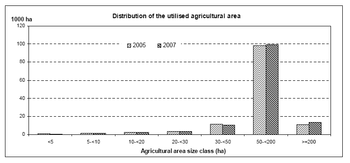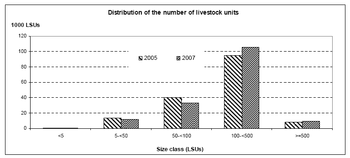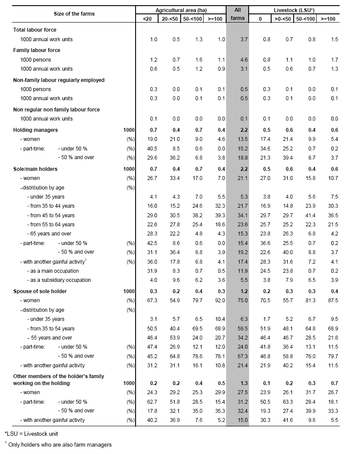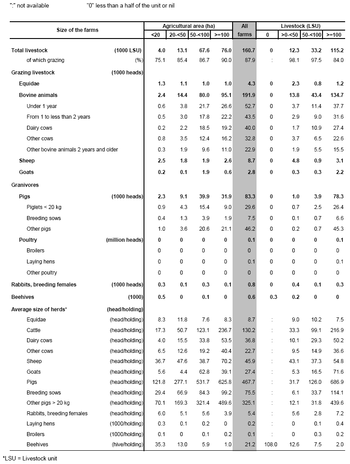Archive:Pig farming sector - statistical portrait 2014
- Data from 2008, most recent data: Further Eurostat information, Main tables and Database.
Pigmeat is produced throughout the EU on several types of farms with considerable variations from one Member State to another. Three quarters of the pigs are reared by just 1.5% of the largest fatteners. Small pig producers are mostly found in the new Member States and are one of the reasons for the decreasing size of the herd. The tasks of pig rearing are distributed across farms and, in the main production basins, even across regions.
Main statistical findings
Regional data on livestock are more informative than national figures as a means of displaying the zones of pig production (Figure 1). The major production basin extends from Denmark to Vlaams Gewest (BE) and accounts for 30% of EU sows. However, there are other important regions, such as Cataluña, Murcia (ES), Lombardia (IT), Bretagne (FR) and some areas of central Poland and Northern Croatia.
Data sources and availability
Due to the different coverage of the FSS across Member States, the total number of farms is not comparable between countries. This is why the present analysis, including Tables 1-4 and the graphs focus on holdings of at least one European size unit (ESU).
The survey on the structure of agricultural holdings in Luxembourg was carried out in May 2007 on an exhaustive base, by the Luxembourg Central Statistical and Economic Studies Office (STATEC) in collaboration with the 116 municipalities of the country and the Rural Economy Office (Service d'Economie Rurale -SER).
The agricultural census has been conducted yearly since 1953. The reference date of the FSS 2007 was the 15 May 2007, however for the farm labour force characteristics the reference period covers the 12 preceding months.
The FSS relates to holdings whose utilized agricultural area is one hectare or more and those whose area is less than one hectare but produce for sale (including livestock) or have at least 100 m2 of vineyard. The target population was all the farms with an operating base located in the Grand Duchy of Luxembourg. The list of holdings was updated and completed at municipality level prior to the census, data from the SER were also used to check the completeness of the population. Administrative sources from the SER were used to determine agricultural areas and livestock. The organic farming data were checked using data from the Administration of the technical services of agriculture in Luxembourg.
The data have been checked several times during processing: at municipality level (when collecting the questionnaires and when compiling the data) and then at a national level using software. The national data are checked against the municipal lists and tables from previous years. The no-response rate is not significant (0.5 %) and the missing data are imputed from previous surveys.
Between FSS 2005 and 2007 "maintaining land in good agricultural and environmental conditions" (GAEC) became an agricultural activity and the land concerned with this new activity has been included in the agricultural area. In Luxembourg it covers 260 ha, 96 % being in farms with at least one ESU.
For each activity (`enterprise`) on a farm (for instance producing wheat, dairy cow or vineyard), a Standard gross margin (SGM) is estimated, based on the area (or the head count of livestock) and a regional coefficient. The sum of such margins in a farm is its economic size, expressed in European size units (ESU). One ESU is equivalent to 1200 EUR SGM.
An 'annual work unit' (AWU) is equivalent to a worker employed on a full time basis for one year. In Luxembourg it is 2 200 hours (275 working days of 8 working hours per day) provided the person is between 15 and 80 years.
A 'livestock unit' (LSU) is equivalent to a dairy cow. The number of animals (number of heads) is converted into LSU using a set of coefficients reflecting the feed requirements of the different animal categories.
Context
European Commission Rural development policy aims to improve competitiveness in agriculture and forestry, improve the environment and countryside, improve the quality of life in rural areas and encourage the diversification of rural economies.
As agriculture has modernized and the importance of industry and services within the economy has increased, so agriculture has become much less important as a source of jobs. Consequently, increasing emphasis is placed on the role farmers can play in rural development, including forestry, biodiversity, the diversification of the rural economy to create alternative jobs and environmental protection in rural areas.
The FSS continues to adapt to provide timely and relevant data to help analyse and follow these developments.
Further Eurostat information
Publications
- Farm Structure Survey in Luxembourg - 2007 - Statistics in focus 96/2008
- National Methodological Report – FSS 2007 Luxembourg (available on request)
Main tables
- Agriculture, see:
- Structure of agricultural holdings (t_ef)
Database
- Agriculture, see:
- Structure of agricultural holdings (ef)
Dedicated section
- Agriculture, see:
- Ad-hoc tables: Farm Structure Survey







